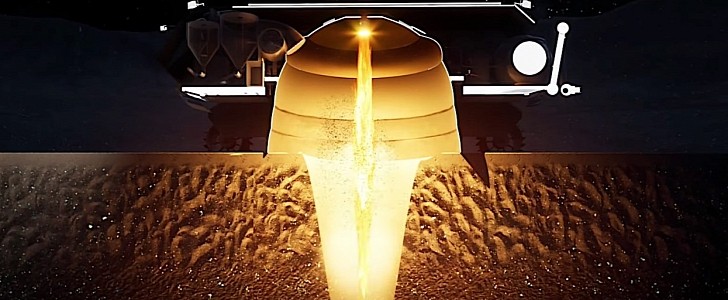In light of the upcoming Artemis lunar missions, many organizations are scrambling to find solutions that would help future generations set up a permanent base there. Most of them focus on the utilization of in-situ resources instead of having them sent all the way from Earth. And there is no more precious resource than water.
We’ve known for a while now that water is a given on the Moon. The Apollo 14 mission in 1971 was the first to stumble upon the life-giving substance, and since then, we’ve found signs of it in the ice at the satellite's poles.
Knowing it’s there doesn’t make it easily accessible, though, and some technology would have to be devised to extract it. The so-called Masten Rocket Mining System is one of the proposed technologies.
Developed by Masten Space Systems, Lunar Outpost, and Honeybee Robotics, the tech is straightforward: it uses the hot plume of a rocket firing to fluidize ice regolith and “rapidly extract frozen volatiles from the Moon.”
The solution envisioned by the three companies involves a 100 lbf rocket engine fired under a pressurized dome. This approach should create ejecta that would get funneled through a vacuum-like system and have ice particles separated from dust and other debris. The ice would then be stored inside containers and shipped to wherever it’s needed.
According to Masten, each such mining rocket is small enough to be delivered to the site through a rover (details in the video below) and could mine up to 12 craters per day, getting some 100 kg (220 pounds) of ice per crater.
Masten says its approach is better than conventional mining tech because it could dig for volatiles “around boulders, breccia, basalt, and other obstacles.” The system is also scalable, and more importantly, each rocket engine could function on oxygen and hydrogen obtained from the soil it mines itself.
The idea, called ROCKET M, which is short for Resource Ore Concentrator Using Kinetic Energy Targeted Mining, is still in testing stages, but Masten plans to have a prototype ready soon.
Knowing it’s there doesn’t make it easily accessible, though, and some technology would have to be devised to extract it. The so-called Masten Rocket Mining System is one of the proposed technologies.
Developed by Masten Space Systems, Lunar Outpost, and Honeybee Robotics, the tech is straightforward: it uses the hot plume of a rocket firing to fluidize ice regolith and “rapidly extract frozen volatiles from the Moon.”
The solution envisioned by the three companies involves a 100 lbf rocket engine fired under a pressurized dome. This approach should create ejecta that would get funneled through a vacuum-like system and have ice particles separated from dust and other debris. The ice would then be stored inside containers and shipped to wherever it’s needed.
According to Masten, each such mining rocket is small enough to be delivered to the site through a rover (details in the video below) and could mine up to 12 craters per day, getting some 100 kg (220 pounds) of ice per crater.
Masten says its approach is better than conventional mining tech because it could dig for volatiles “around boulders, breccia, basalt, and other obstacles.” The system is also scalable, and more importantly, each rocket engine could function on oxygen and hydrogen obtained from the soil it mines itself.
The idea, called ROCKET M, which is short for Resource Ore Concentrator Using Kinetic Energy Targeted Mining, is still in testing stages, but Masten plans to have a prototype ready soon.









